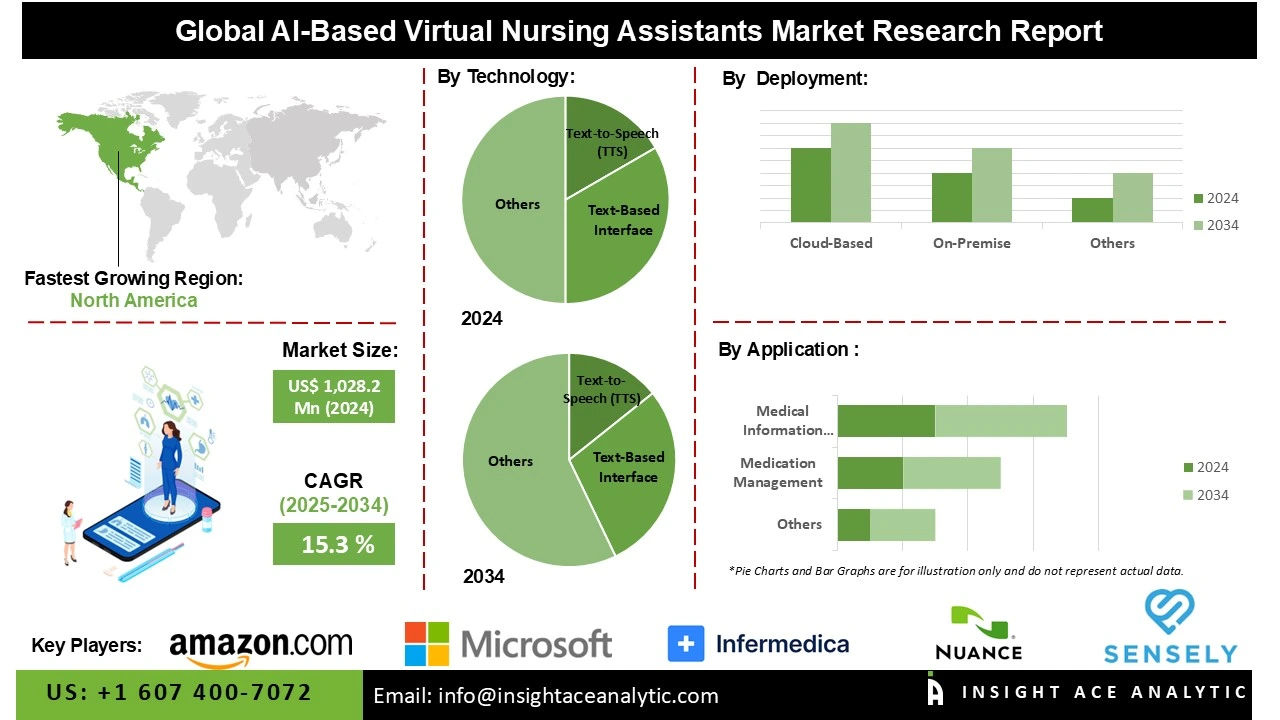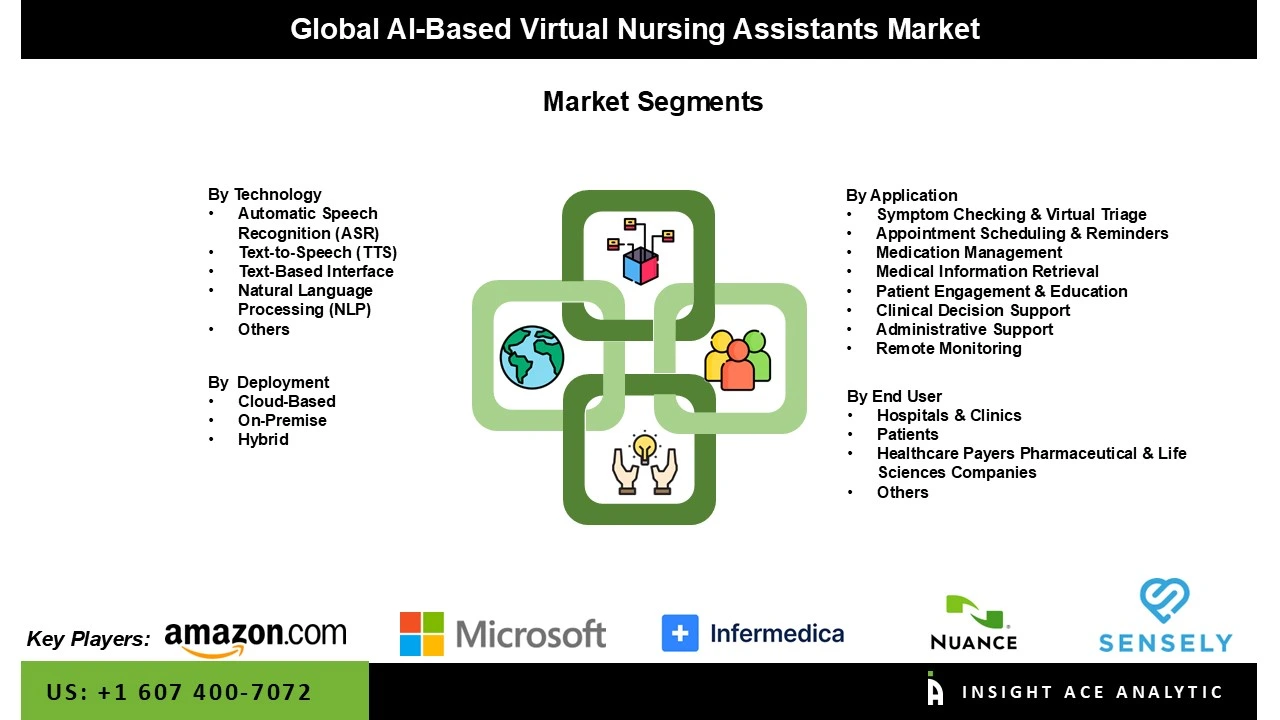Global AI-Based Virtual Nursing Assistant Market Size is valued at US$ 1,028.2 Mn in 2024 and is predicted to reach US$ 4,104.5 Mn by the year 2034 at an 15.3% CAGR during the forecast period for 2025-2034.
Virtual nurse assistants powered by AI are revolutionizing healthcare by offering prescription reminders, individualized health advice, and ongoing patient monitoring. They reduce hospital readmissions by helping with appointment scheduling, chronic disease management, and post-discharge assistance. which leverage artificial intelligence to support patients through voice or text-based interfaces, are becoming essential tools in modern healthcare delivery due to their 24/7 availability, scalability, and ability to streamline both clinical and administrative tasks in diverse healthcare environments.

The global AI-based virtual nursing assistant market is expanding due to the rising demand for remote patient monitoring, the rising incidence of chronic disease , technological advancements in AI, and the need for cost-effective, patient-centered healthcare solutions.
The rising incidence of chronic disease is another element propelling the AI-based virtual nursing assistant market. There is a growing need for AI-based virtual nursing assistants that facilitate remote management, reduce hospital visits, and enhance treatment outcomes, as chronic disease cases require ongoing monitoring, individualized care, and patient participation. The WHO states that chronic disease prevalence is high and increasing, with global statistics showing 73% of deaths from non-communicable diseases (NCDs), and ~1.8 billion adults globally at risk due to inactivity. However, data privacy issues, the high cost of implementation, and integration challenges with existing healthcare systems are among the obstacles impeding the growth of the AI-based virtual nursing assistant market. Particular technical developments, such as the growth of telehealth and digital health platforms, will generate opportunities for the AI-based virtual nursing assistant market over the forecast period.
Some of the Key Players in AI-Based Virtual Nursing Assistant Market:
· Sensely, Inc.
· Infermedica
· Microsoft Corporation
· Nuance Communications, Inc.
· HealthTap, Inc.
· Amazon.com, Inc.
· Google LLC
· Syllable Corporation
· Catalia Health, Inc.
· ADA Health GmbH
· Hyro Inc.
· Florence Healthcare, Inc.
· Buoy Health, Inc.
· Well Health Inc.
· Binah.ai Ltd.
· GYANT, Inc.
· K Health, Inc.
· Komodo Health, Inc.
· eVisit, Inc.
The AI-based virtual nursing assistant market is segmented by technology, deployment, application, and end user. By technology, the market is segmented into automatic speech recognition (asr), text-to-speech (tts), text-based interface, natural language processing (nlp), and others. By deployment, the market is segmented into cloud-based, on-premise, and hybrid. By application, the market is segmented into symptom, checking & virtual triage, appointment scheduling & reminders, medication management, medical information retrieval, patient engagement & education, clinical decision support, administrative support, and remote monitoring. By end user, the market is segmented into hospitals & clinics, patients, healthcare payers, pharmaceutical & life sciences companies, and others.
The Automatic Speech Recognition (ASR) category led the AI-based virtual nursing assistant market in 2024. This convergence is because of rising demand for voice-enabled systems that can accurately interpret patient input and respond conversationally. ASR improves the efficiency of digital triage, symptom checking, and health assessments, supporting hands-free interaction across various healthcare settings
The largest and fastest-growing deployment is cloud-based, a trend is due to the cloud platforms' affordability, scalability, and ease of integration, which allow healthcare organizations to swiftly implement AI-driven assistants without having to make significant expenditures in IT infrastructure. Centralized patient record access and real-time data changes are also supported by cloud systems.
North America dominated the AI-based virtual nursing assistant market in 2024. The United States is at the forefront of this expansion. This is due to the substantial investments in AI-driven solutions, a high acceptance rate of digital health technology, and advanced healthcare infrastructure. The need for distant patient care is growing in the area due to the high prevalence of chronic diseases and the significant number of elderly residents. North America is the biggest regional contributor to the market because to its strong telehealth infrastructure, supportive government policies, and presence of top AI healthcare businesses.
Increasing adoption of AI technologies, rapid healthcare digitization, and increased knowledge of virtual care alternativesin the Asia-Pacific area, the AI-Based Virtual Nursing Assistant market is expanding at the strongest and fastest rate in this region. The requirement for patient support and remote monitoring is fueled by the rise in chronic illnesses and older people. Adoption is being pushed forward by government initiatives encouraging intelligent healthcare solutions, investments in AI healthcare firms, and growing telemedicine infrastructure. Enhanced internet access and affordable AI solutions contribute to the region's prosperity.
AI-Based Virtual Nursing Assistant Market by Technology-
· Automatic Speech Recognition (ASR)
· Text-to-Speech (TTS)
· Text-Based Interface
· Natural Language Processing (NLP)
· Others

AI-Based Virtual Nursing Assistant Market by Deployment-
· Cloud-Based
· On-Premise
· Hybrid
AI-Based Virtual Nursing Assistant Market by Application-
· Symptom Checking & Virtual Triage
· Appointment Scheduling & Reminders
· Medication Management
· Medical Information Retrieval
· Patient Engagement & Education
· Clinical Decision Support
· Administrative Support
· Remote Monitoring
AI-Based Virtual Nursing Assistant Market by End User-
· Hospitals & Clinics
· Patients
· Healthcare Payers
· Pharmaceutical & Life Sciences Companies
· Others
AI-Based Virtual Nursing Assistant Market by Region-
North America-
· The US
· Canada
Europe-
· Germany
· The UK
· France
· Italy
· Spain
· Rest of Europe
Asia-Pacific-
· China
· Japan
· India
· South Korea
· Southeast Asia
· Rest of Asia Pacific
Latin America-
· Brazil
· Argentina
· Mexico
· Rest of Latin America
Middle East & Africa-
· GCC Countries
· South Africa
· Rest of the Middle East and Africa
Chapter 1. Methodology and Scope
1.1. Research Methodology
1.2. Research Scope & Assumptions
Chapter 2. Executive Summary
Chapter 3. Global AI-Based Virtual Nursing Assistants Market Snapshot
Chapter 4. Global AI-Based Virtual Nursing Assistants Market Variables, Trends & Scope
4.1. Market Segmentation & Scope
4.2. Drivers
4.3. Challenges
4.4. Trends
4.5. Investment and Funding Analysis
4.6. Porter's Five Forces Analysis
4.7. Incremental Opportunity Analysis (US$ MN), 2025-2034
4.8. Competitive Landscape & Market Share Analysis, By Key Player (2024)
4.9. Use/impact of AI on AI-Based Virtual Nursing Assistants Market Industry Trends
4.10. Global AI-Based Virtual Nursing Assistants Market Penetration & Growth Prospect Mapping (US$ Mn), 2024-2034
Chapter 5. AI-Based Virtual Nursing Assistants Market Segmentation 1: By Technology, Estimates & Trend Analysis
5.1. Market Share by Technology, 2024 & 2034
5.2. Market Size Revenue (US$ Million) & Forecasts and Trend Analyses, 2021 to 2034 for the following Technology:
5.2.1. Automatic Speech Recognition (ASR)
5.2.2. Text-to-Speech (TTS)
5.2.3. Text-Based Interface
5.2.4. Natural Language Processing (NLP)
5.2.5. Others
Chapter 6. AI-Based Virtual Nursing Assistants Market Segmentation 2: Deployment, Estimates & Trend Analysis
6.1. Market Share by Deployment, 2024 & 2034
6.2. Market Size Revenue (US$ Million) & Forecasts and Trend Analyses, 2021 to 2034 for the following Deployment:
6.2.1. Cloud-Based
6.2.2. On-Premise
6.2.3. Hybrid
Chapter 7. AI-Based Virtual Nursing Assistants Market Segmentation 3: By Application, Estimates & Trend Analysis
7.1. Market Share by Application, 2024 & 2034
7.2. Market Size Revenue (US$ Million) & Forecasts and Trend Analyses, 2021 to 2034 for the following Application:
7.2.1. Symptom Checking & Virtual Triage
7.2.2. Appointment Scheduling & Reminders
7.2.3. Medication Management
7.2.4. Medical Information Retrieval
7.2.5. Patient Engagement & Education
7.2.6. Clinical Decision Support
7.2.7. Administrative Support
7.2.8. Remote Monitoring
Chapter 8. AI-Based Virtual Nursing Assistants Market Segmentation 4: By End User, Estimates & Trend Analysis
8.1. Market Share by End User, 2024 & 2034
8.2. Market Size Revenue (US$ Million) & Forecasts and Trend Analyses, 2021 to 2034 for the following End User:
8.2.1. Hospitals & Clinics
8.2.2. Patients
8.2.3. Healthcare Payers Pharmaceutical & Life Sciences Companies
8.2.4. Others
Chapter 9. AI-Based Virtual Nursing Assistants Market Segmentation 5: Regional Estimates & Trend Analysis
9.1. Global AI-Based Virtual Nursing Assistants Market, Regional Snapshot 2024 & 2034
9.2. North America
9.2.1. North America AI-Based Virtual Nursing Assistants Market Revenue (US$ Million) Estimates and Forecasts by Country, 2021-2034
9.2.1.1. US
9.2.1.2. Canada
9.2.2. North America AI-Based Virtual Nursing Assistants Market Revenue (US$ Million) Estimates and Forecasts by Technology, 2021-2034
9.2.3. North America AI-Based Virtual Nursing Assistants Market Revenue (US$ Million) Estimates and Forecasts by Deployment, 2021-2034
9.2.4. North America AI-Based Virtual Nursing Assistants Market Revenue (US$ Million) Estimates and Forecasts by Application, 2021-2034
9.2.5. North America AI-Based Virtual Nursing Assistants Market Revenue (US$ Million) Estimates and Forecasts by End User, 2021-2034
9.3. Europe
9.3.1. Europe AI-Based Virtual Nursing Assistants Market Revenue (US$ Million) Estimates and Forecasts by Country, 2021-2034
9.3.1.1. Germany
9.3.1.2. U.K.
9.3.1.3. France
9.3.1.4. Italy
9.3.1.5. Spain
9.3.1.6. Rest of Europe
9.3.2. Europe AI-Based Virtual Nursing Assistants Market Revenue (US$ Million) Estimates and Forecasts by Technology, 2021-2034
9.3.3. Europe AI-Based Virtual Nursing Assistants Market Revenue (US$ Million) Estimates and Forecasts by Deployment, 2021-2034
9.3.4. Europe AI-Based Virtual Nursing Assistants Market Revenue (US$ Million) Estimates and Forecasts by Application, 2021-2034
9.3.5. Europe AI-Based Virtual Nursing Assistants Market Revenue (US$ Million) Estimates and Forecasts by End User, 2021-2034
9.4. Asia Pacific
9.4.1. Asia Pacific AI-Based Virtual Nursing Assistants Market Revenue (US$ Million) Estimates and Forecasts by Country, 2021-2034
9.4.1.1. India
9.4.1.2. China
9.4.1.3. Japan
9.4.1.4. Australia
9.4.1.5. South Korea
9.4.1.6. Hong Kong
9.4.1.7. Southeast Asia
9.4.1.8. Rest of Asia Pacific
9.4.2. Asia Pacific AI-Based Virtual Nursing Assistants Market Revenue (US$ Million) Estimates and Forecasts by Technology, 2021-2034
9.4.3. Asia Pacific AI-Based Virtual Nursing Assistants Market Revenue (US$ Million) Estimates and Forecasts by Deployment, 2021-2034
9.4.4. Asia Pacific AI-Based Virtual Nursing Assistants Market Revenue (US$ Million) Estimates and Forecasts by Application, 2021-2034
9.4.5. Asia Pacific AI-Based Virtual Nursing Assistants Market Revenue (US$ Million) Estimates and Forecasts by End User, 2021-2034
9.5. Latin America
9.5.1. Latin America AI-Based Virtual Nursing Assistants Market Revenue (US$ Million) Estimates and Forecasts by Country, 2021-2034
9.5.1.1. Brazil
9.5.1.2. Mexico
9.5.1.3. Rest of Latin America
9.5.2. Latin America AI-Based Virtual Nursing Assistants Market Revenue (US$ Million) Estimates and Forecasts by Technology, 2021-2034
9.5.3. Latin America AI-Based Virtual Nursing Assistants Market Revenue (US$ Million) Estimates and Forecasts by Deployment, 2021-2034
9.5.4. Latin America AI-Based Virtual Nursing Assistants Market Revenue (US$ Million) Estimates and Forecasts by Application, 2021-2034
9.5.5. Latin America AI-Based Virtual Nursing Assistants Market Revenue (US$ Million) Estimates and Forecasts by End User, 2021-2034
9.6. Middle East & Africa
9.6.1. Middle East & Africa Wind Turbine Rotor Blade Market Revenue (US$ Million) Estimates and Forecasts by country, 2021-2034
9.6.1.1. GCC Countries
9.6.1.2. Israel
9.6.1.3. South Africa
9.6.1.4. Rest of Middle East and Africa
9.6.2. Middle East & Africa AI-Based Virtual Nursing Assistants Market Revenue (US$ Million) Estimates and Forecasts by Technology, 2021-2034
9.6.3. Middle East & Africa AI-Based Virtual Nursing Assistants Market Revenue (US$ Million) Estimates and Forecasts by Deployment, 2021-2034
9.6.4. Middle East & Africa AI-Based Virtual Nursing Assistants Market Revenue (US$ Million) Estimates and Forecasts by Application, 2021-2034
9.6.5. Middle East & Africa AI-Based Virtual Nursing Assistants Market Revenue (US$ Million) Estimates and Forecasts by End User, 2021-2034
Chapter 10. Competitive Landscape
10.1. Major Mergers and Acquisitions/Strategic Alliances
10.2. Company Profiles
10.2.1. Sensely, Inc. (U.S.)
10.2.1.1. Business Overview
10.2.1.2. Key Type /Service Overview
10.2.1.3. Financial Performance
10.2.1.4. Geographical Presence
10.2.1.5. Recent Developments with Business Strategy
10.2.2. Infermedica (Poland)
10.2.3. Microsoft Corporation (U.S.)
10.2.4. Nuance Communications, Inc. (U.S.)
10.2.5. HealthTap, Inc. (U.S.)
10.2.6. Amazon.com, Inc. (U.S.)
10.2.7. Google LLC (Google Health) (U.S.)
10.2.8. Syllable Corporation (U.S.)
10.2.9. Catalia Health, Inc. (U.S.)
10.2.10. ADA Health GmbH (Germany)
10.2.11. Hyro Inc. (U.S.)
10.2.12. Florence Healthcare, Inc. (U.S.)
10.2.13. Buoy Health, Inc. (U.S.)
10.2.14. Well Health Inc. (U.S.)
10.2.15. Binah.ai Ltd. (Israel)
10.2.16. GYANT, Inc. (U.S.)
10.2.17. K Health, Inc. (U.S.)
10.2.18. Komodo Health, Inc. (U.S.)
10.2.19. eVisit, Inc. (U.S.)